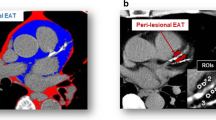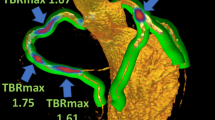Abstract
Purpose
The predictive value of 18F-sodium fluoride (18F-NaF) positron emission tomography (PET) in combination with coronary computed tomography (CT) angiography (CCTA) for future coronary events has attracted interest. We evaluated the potential of 18F-NaF PET/CT following CCTA to predict major coronary events (MACE) during a 5-year follow-up period.
Methods
Forty patients with coronary atherosclerotic lesions detected on CCTA underwent 18F-NaF PET/CT examination. Each lesion was evaluated for luminal stenosis and high-risk plaque (HRP) with < 30 Hounsfield units and a > 1.1 remodeling index on CCTA. Focal 18F-NaF uptake in each lesion was quantified using the maximum tissue-to-background ratio (TBRmax), and the maximum TBRmax per patient (M-TBRmax) was determined. We followed MACE (cardiac death, acute coronary syndrome, and/or coronary revascularization > 6 months after 18F-NaF PET/CT) for 5 years.
Results
In total, 142 coronary lesions were analyzed. Eleven patients experienced any MACE. Patients with MACE showed a higher M-TBRmax than those without (1.40 ± .19 vs. 1.18 ± .18, P = .0011), and the optimal M-TBRmax cutoff to predict MACE was 1.29. Patients with M-TBRmax of ≥ 1.29 had a higher risk of MACE than those with lower values (P = .012, log-rank test), whereas patients with obstructive stenosis and those with HRP did not. Multivariate Cox proportional analysis adjusted for age, sex, coronary risk factors, and CCTA findings showed that M-TBRmax of ≥ 1.29 remained an independent predictor of 5-year MACE (hazard ratio, 5.4; 95% confidence interval, 1.1–25.4; P = .034).
Conclusion
18F-NaF PET/CT following CCTA provides useful strategies to predict 5-year MACE.






Similar content being viewed by others
Abbreviations
- ACS:
-
Acute coronary syndrome
- CAD:
-
Coronary artery disease
- CCTA:
-
Coronary computed tomography angiography
- CT:
-
Computed tomography
- 18F-NaF:
-
18F-sodium fluoride
- HRP:
-
High-risk plaque
- MACE:
-
Major coronary events
- PET:
-
Positron emission tomography
- M-TBRmax :
-
Maximum TBRmax per patient
- TBRmax :
-
Maximum tissue-to-background ratio
References
Derlin T, Tóth Z, Papp L, Wisotzki C, Apostolova I, Habermann CR. Correlation of inflammation assessed by 18F-FDG PET, active mineral deposition assessed by 18F-fluoride PET, and vascular calcification in atherosclerotic plaque: a dual tracer PET/CT study. J Nucl Med 2011;52:1020‐7.
Dweck MR, Chow MW, Joshi NV, Williams MC, Jones C, Fletcher AM, et al. Coronary arterial 18F-sodium fluoride uptake: a novel marker of plaque biology. J Am Coll Cardiol 2012;59:1539‐48.
Aikawa E, Nahrendorf M, Figueiredo JL, Swirski FK, Shtatland T, Kohler RH, et al. Osteogenesis associates with inflammation in early-stage atherosclerosis evaluated by molecular imaging in vivo. Circulation 2007;116:2841‐50.
New SE, Goettsch C, Aikawa M, Marchini JF, Shibasaki M, Yabusaki K, et al. Macrophage-derived matrix vesicles: an alternative novel mechanism for microcalcification in atherosclerotic plaques. Circ Res 2013;113:72‐7.
Kitagawa T, Nakano Y. Innovative atherosclerosis imaging using 18F-NaF PET/CT: its clinical potential. J Nucl Cardiol 2022;29:1724‐8.
Kitagawa T, Yamamoto H, Toshimitsu S, Sasaki K, Senoo A, Kubo Y, et al. 18F-sodium fluoride positron emission tomography for molecular imaging of coronary atherosclerosis based on computed tomography analysis. Atherosclerosis 2017;263:385‐92.
Kwiecinski J, Dey D, Cadet S, Lee SE, Tamarappoo B, Otaki Y, et al. Predictors of 18F-sodium fluoride uptake in patients with stable coronary artery disease and adverse plaque features on computed tomography angiography. Eur Heart J Cardiovasc Imaging 2020;21:58‐66.
Majeed K, Bellinge JW, Butcher SC, Alcock R, Spiro J, Playford D, et al. Coronary 18F-sodium fluoride PET detects high-risk plaque features on optical coherence tomography and CT-angiography in patients with acute coronary syndrome. Atherosclerosis 2021;219:142‐8.
Kitagawa T, Yamamoto H, Nakamoto Y, Sasaki K, Toshimitsu S, Tatsugami F, et al. Predictive value of 18F-sodium fluoride positron emission tomography in detecting high-risk coronary artery disease in combination with computed tomography. J Am Heart Assoc 2018;7:e010224.
Kwiecinski J, Tzolos E, Adamson PD, Cadet S, Moss AJ, Joshi N, et al. Coronary 18F-sodium fluoride uptake predicts outcomes in patients with coronary artery disease. J Am Coll Cardiol 2020;75:3061‐74.
Raff GL, Abidov A, Achenbach S, Berman DS, Boxt LM, Budoff MJ, et al. SCCT guidelines for the interpretation and reporting of coronary computed tomographic angiography. J Cardiovasc Comput Tomogr 2009;3:122‐36.
Motoyama S, Kondo T, Sarai M, Sugiura A, Harigaya H, Sato T, et al. Multislice computed tomographic characteristics of coronary lesions in acute coronary syndromes. J Am Coll Cardiol 2007;50:319‐26.
Motoyama S, Sarai M, Harigaya H, Anno H, Inoue K, Hara T, et al. Computed tomographic angiography characteristics of atherosclerotic plaques subsequently resulting in acute coronary syndrome. J Am Coll Cardiol 2009;54:49‐57.
Braunwald E, Antman EM, Beasley JW, Califf RM, Cheitlin MD, Hochman JS, et al. ACC/AHA guideline update for the management of patients with unstable angina and non-ST-segment elevation myocardial infarction—2002: summary article: a report of the American College of Cardiology/American Heart Association Task Force on Practice Guidelines (Committee on the Management of Patients With Unstable Angina). Circulation 2002;106:1893‐900.
Thygesen K, Alpert JS, Jaffe AS, Simoons ML, Chaitman BR, White HD, et al. Third universal definition of myocardial infarction. J Am Coll Cardiol 2012;60:1581‐98.
Budoff MJ, Shaw LJ, Liu ST, Weinstein SR, Mosler TP, Tseng PH, et al. Long-term prognosis associated with coronary calcification: observations from a registry of 25,253 patients. J Am Coll Cardiol 2007;49:1860‐70.
Detrano R, Guerci AD, Carr JJ, Bild DE, Burke G, Folsom AR, et al. Coronary calcium as a predictor of coronary events in four racial or ethnic groups. N Engl J Med 2008;358:1336‐45.
Ishiwata Y, Kaneta T, Nawata S, Hino-Shishikura A, Yoshida K, Inoue T. Quantification of temporal changes in calcium score in active atherosclerotic plaque in major vessels by 18F-sodium fluoride PET/CT. Eur J Nucl Med Mol Imaging 2017;44:1529‐37.
Li X, Heber D, Cal-Gonzalez J, Karanikas G, Mayerhoefer ME, Rasul S, et al. Association between osteogenesis and inflammation during the progression of calcified plaque evaluated by 18F-Fluoride and 18F-FDG. J Nucl Med 2017;58:968‐74.
Nakamoto Y, Kitagawa T, Sasaki K, Tatsugami F, Awai K, Hirokawa Y, et al. Clinical implications of 18F-sodium fluoride uptake in subclinical aortic valve calcification: its relation to coronary atherosclerosis and its predictive value. J Nucl Cardiol 2019;28:1522‐31.
Bellinge JW, Francis RJ, Lee SC, Phillips M, Rajwani A, Lewis JR, et al. 18F-sodium fluoride positron emission tomography activity predicts the development of new coronary artery calcifications. Arterioscler Thromb Vasc Biol 2021;41:534‐41.
Doris MK, Meah MN, Moss AJ, Andrews JPM, Bing R, Gillen R, et al. Coronary 18F-fluoride uptake and progression of coronary artery calcification. Circ Cardiovasc Imaging 2020;13:e011438.
Kwiecinski J, Tzolos E, Fletcher AJ, Nash J, Meah MN, Cadet S, et al. Bypass grafting and native coronary artery disease activity. JACC Cardiovasc Imaging 2022;15:875‐87.
Lee JM, Bang JI, Koo BK, Hwang D, Park J, Zhang J, et al. Clinical relevance of 18F-sodium fluoride positron-emission tomography in noninvasive identification of high-risk plaque in patients with coronary artery disease. Circ Cardiovasc Imaging 2017;10:e006704.
Kwiecinski J, Tzolos E, Meah MN, Cadet S, Adamson PD, Grodecki K, et al. Machine learning with 18F-sodium fluoride PET and quantitative plaque analysis on CT angiography for the future risk of myocardial infarction. J Nucl Med 2022;63:158‐65.
Kitagawa T, Sasaki K, Fujii Y, Tatsugami F, Awai K, Hirokawa Y, et al. A longitudinal pilot study to assess temporal changes in coronary arterial 18F-sodium fluoride uptake. J Nucl Cardiol 2022 (in press).
Acknowledgments
We acknowledge the help and support of the radiography and radiochemistry staffs of the Hiroshima Heiwa Clinic. We thank Angela Morben, DVM, ELS, from Edanz (https://jp.edanz.com/ac), for editing a draft of this manuscript.
Funding
This work was supported in part by the Mochida Memorial Foundation for Medical and Pharmaceutical Research, and a JSPS KAKENHI Grant-in-Aid for Scientific Research (Grant Number 21K08127).
Author information
Authors and Affiliations
Corresponding author
Ethics declarations
Disclosures
Toshiro Kitagawa, Ko Sasaki, Yuto Fujii, Yuki Ikegami, Fuminari Tatsugami, Kazuo Awai, Yutaka Hirokawa, and Yukiko Nakano report no relevant disclosures.
Additional information
Publisher's Note
Springer Nature remains neutral with regard to jurisdictional claims in published maps and institutional affiliations.
The authors of this article have provided a PowerPoint file, available for download at SpringerLink, which summarises the contents of the paper and is free for re-use at meetings and presentations. Search for the article DOI on SpringerLink.com.
Supplementary Information
Below is the link to the electronic supplementary material.
12350_2023_3277_MOESM1_ESM.tif
Supplementary Figure Kaplan–Meier curves for 5-year MACE stratified according to CCS (A), and receiver operating characteristic curves of CCS and M-TBRmax for predicting MACE (B). CCS, coronary calcium score; other abbreviations as Figure 1 and 2. Supplementary file1 (TIF 2090 kb)
Rights and permissions
Springer Nature or its licensor (e.g. a society or other partner) holds exclusive rights to this article under a publishing agreement with the author(s) or other rightsholder(s); author self-archiving of the accepted manuscript version of this article is solely governed by the terms of such publishing agreement and applicable law.
About this article
Cite this article
Kitagawa, T., Sasaki, K., Fujii, Y. et al. 18F-sodium fluoride positron emission tomography following coronary computed tomography angiography in predicting long-term coronary events: a 5-year follow-up study. J. Nucl. Cardiol. 30, 2365–2378 (2023). https://doi.org/10.1007/s12350-023-03277-5
Received:
Accepted:
Published:
Issue Date:
DOI: https://doi.org/10.1007/s12350-023-03277-5




